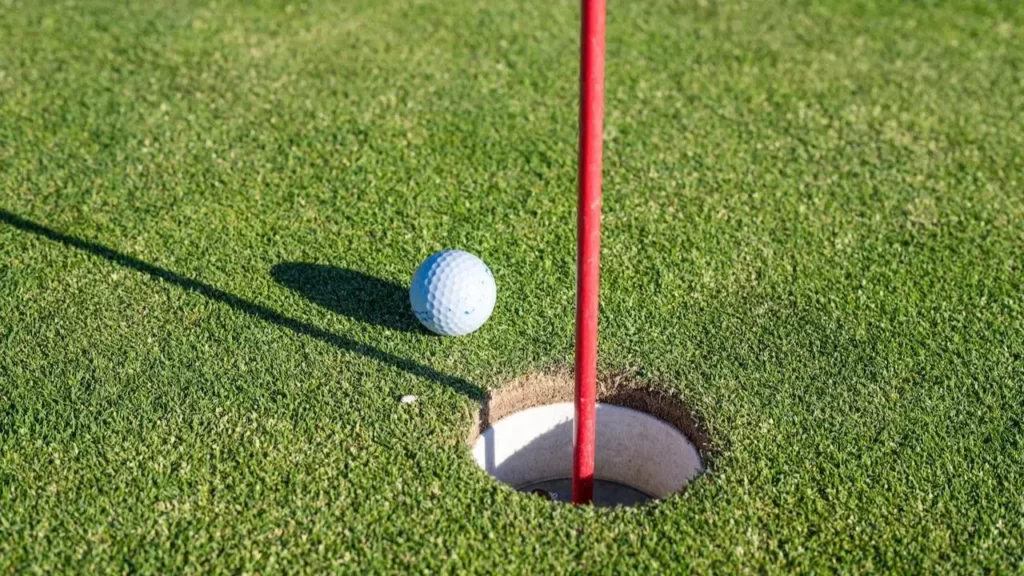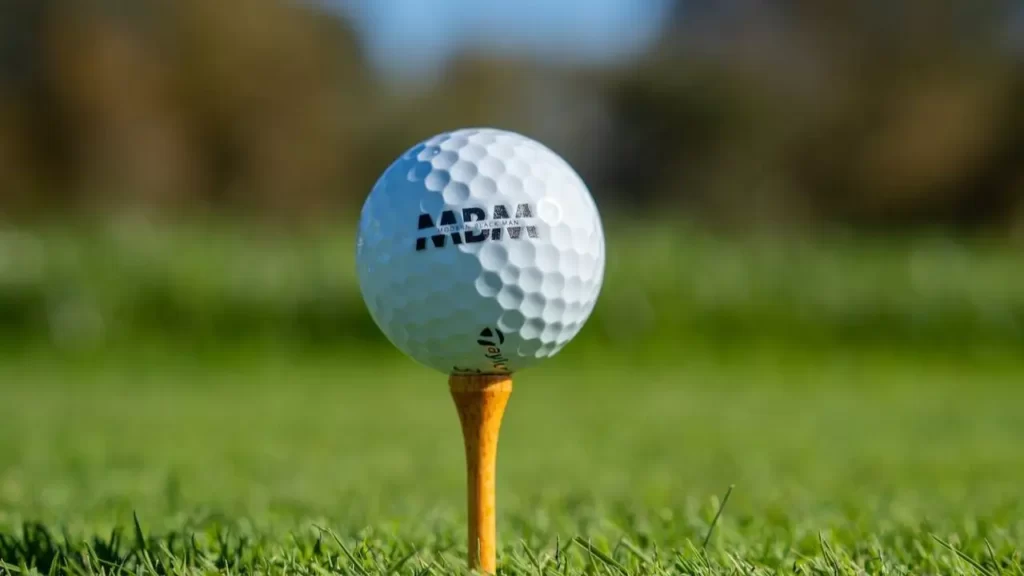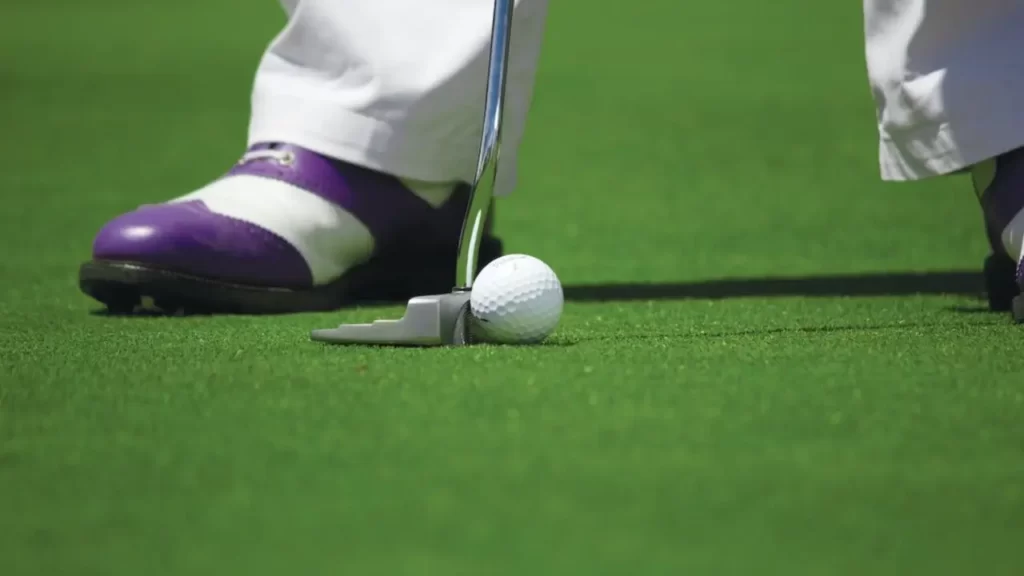From Dimples to Diameter: How Big Is a Golf Ball Really?
- Last updated on November 6, 2023
- Toni Benedito
- Golf Equipment & Gear, Blog
Curious about the size of a golf ball? In the world of golf, precision matters, and the golf ball is no exception. The standard size, as regulated by the USGA, is 1.68 inches in diameter. This seemingly small detail has a significant impact on your game, affecting distance, accuracy, and overall performance on the course.

Key Takeaways
- The USGA-regulated standard golf ball size is 1.68 inches in diameter, a critical detail that influences how far your shots travel and your control over the game.
- Understanding the historical variations in golf ball sizes reveals the evolution of this essential piece of golf equipment.
- Beyond size, golf ball weight and construction play pivotal roles in a golfer’s performance and ability to adapt to various conditions and playing styles.
- When choosing the right golf ball, consider factors like size, dimple patterns, weight, and adherence to regulatory standards set by organizations like the USGA.
- A properly sized golf ball, meeting all the regulations, is not just a small detail; it’s the key to fair play, optimal performance, and a more enjoyable golfing experience.
Introduction
Are you curious about how big a golf ball is? It’s a question that many golfers and non-golfers alike have probably asked at some point.
Golf balls are small, but they play a crucial role in the game of golf. In this article, we’ll explore the different aspects of golf ball size and why it matters.
Let’s start with the basics. The standard size of a golf ball is 1.68 inches in diameter, according to USGA (United States Golf Association) regulations.
This may seem small, but it’s actually just the right size for the game of golf. The circumference of a standard-sized golf ball is around 5.25 inches.
Interestingly, the current standard size of a golf ball wasn’t always the norm. In fact, there have been several different sizes throughout history before it was standardized by USGA regulations in 1932.
Early versions of golf balls were actually much larger than what we know today, with diameters ranging from 1.62 to 1.75 inches. So why does the size of a golf ball matter?
Enjoying this article? Read more:
Well, for starters, it affects how far it can travel through the air when hit by a club and how easily it can roll on the green after landing. The weight and dimensions also affect how much control you have over your shots. There are also rules governing minimum and maximum sizes for golf balls in official competition play set by organizations like the USGA and R&A (Royal & Ancient Golf Club).
These regulations ensure fairness among players and help maintain consistency across various tournaments. While they may seem small and inconsequential at first glance, the size of a golf ball has a significant impact on both performance and gameplay in this beloved sport.

The Standard Size of a Golf Ball
Golf is a game that is known for its precision and accuracy, and the golf ball is a crucial element of the game.
It is essential to know the standard size of a golf ball if you want to play like a pro. The rules of the game state that the minimum size of a golf ball can be no less than 1.68 inches in diameter.
This measurement was established by the United States Golf Association (USGA) in 1932, and it still remains unchanged today. The circumference of a standard golf ball must be no less than 5.26 inches, which means that its diameter must be at least 1.68 inches, or 42.67 mm in metric units.
The average weight of a golf ball ranges from 45 to 46 grams, or around 1.62 ounces, as also regulated by the USGA. Golf balls can come in various dimensions, but they are all bound by regulations set by organizations such as the USGA or R&A (Royal and Ancient Golf Club).
These regulations define various aspects such as size, weight, and material used to ensure consistency throughout professional play. These rules are an important aspect of maintaining fairness during professional gameplay since every golfer has access to the same type of equipment, including balls that meet certain standards.
Enjoying this article? Read more:

The History of Golf Ball Size
The History is a fascinating story that spans many centuries. While the modern golf ball is standardized, it was not always that way. In the early days of golf, players would use leather pouches filled with feathers as their balls.
These feather-filled balls were called “featheries” and were generally about 2 inches in diameter. The first standardization of golf ball size occurred in 1932, when the United States Golf Association (USGA) introduced a rule stating that a golf ball must have a minimum diameter of 1.68 inches.
This was done to ensure fairness in the game and prevent players from using an unfairly small ball to gain an advantage. Before this rule was introduced, there was no standard size for golf balls, and they varied greatly in size and weight between manufacturers and countries.
Some early golf balls were significantly smaller than modern ones, with diameters as small as 1 inch or less. One interesting fact about early golf balls is that they did not have dimples like modern ones do.
The first dimpled golf ball was patented by William Taylor in 1905, but it took several years for this design to catch on. Today, all regulation golf balls must be between 1.68 and 1.73 inches in diameter and weigh no more than 1.62 ounces, according to USGA rules.
These regulations are designed to create consistency in the game so that all players are playing with the same equipment, regardless of brand or model choice. While some players may try to push the limits of these regulations by using larger or heavier balls to gain an advantage on the course, doing so is against USGA rules and can result in penalties or disqualification from tournaments if caught breaking them.

The Importance of Golf Ball Size
One might wonder why the size of a golf ball is so important in the game, but it has a significant impact on performance and playability. The size of the golf ball directly impacts its aerodynamics and how it interacts with the air while in flight.
The smaller or larger a golf ball is, the more or less drag it will encounter. This means that if a golf ball is too small or too large, it may not travel as far as intended, making it difficult to achieve accuracy on shots.
Golf ball regulations dictate that there are specific standards for the size of a golf ball that players must adhere to. The United States Golf Association (USGA) sets rules for all aspects of equipment used in games, including the size and weight of a golf ball.
Following these regulations ensures that all players are using equipment with uniform standards for fair play. The circumference of a standard-sized golf ball must measure between 5.26 inches (minimum) and 5.8 inches (maximum), with an average diameter of 1.68 inches.
These dimensions have been established to ensure consistency in gameplay across professional and amateur levels. In addition to adhering to USGA guidelines for fairness’ sake, choosing the right size of the golf ball can help maximize distance and control over shots on the course.
For instance, if you’re using a larger-sized golf ball than what’s standard, you’ll experience increased drag during flight, resulting in shorter distances traveled by your shots than expected—something nobody wants! Therefore, paying attention to details like this can lead to improved performance on your next round out there!
Enjoying this article? Read more:
Variations in Golf Ball Size
Golf balls have come a long way since their early days. In the early days of golf, golfers used wooden balls, which were not very durable. The first golf ball made of rubber was introduced in the mid-19th century and was known as the gutta-percha ball.
This ball had a standardized size of 1.62 inches in diameter and weighed around 1.62 ounces. Today, there are many different variations in golf ball size, although they are all still within the parameters set by the USGA golf ball rules.
Golf balls can be as small as 1.68 inches in diameter or as large as 1.8 inches in diameter, with weight limits ranging from 45 to 63 grams. While these variations may seem minor, they can have a significant impact on a golfer’s game.
For example, a slightly larger or heavier ball may feel more comfortable to some golfers and allow them to hit longer shots with greater accuracy. The size of the hole also plays a role in determining the optimal size of a golf ball for an individual golfer’s game.
A smaller hole may require a smaller and lighter ball to ensure that it fits through the hole properly and travels cleanly down the fairway. Despite these variations in golf ball size, all balls must conform to certain rules and regulations set forth by governing bodies like the USGA.
These regulations ensure that all players are competing on an even playing field and that no one is gaining an unfair advantage through equipment choices. While there is some variation allowed within USGA regulations for golf ball size and weight, it is important for players to carefully consider their options when choosing which type of ball will work best for their game.
Enjoying this article? Read more:

Golf Ball Size vs. Golf Hole Size
When it comes to golf, every detail matters, even the size of the ball. But how does the size of the golf ball compare to the size of the hole? Let’s take a closer look at this important aspect of golf.
Firstly, it’s essential to know that there are specific rules and regulations for golf ball size. According to USGA golf ball rules, a standard golf ball must have a diameter of at least 1.68 inches and a weight of no more than 1.62 ounces.
Therefore, when we consider the size of the hole in comparison, which has an average diameter of 4.25 inches, or approximately four times larger than a standard golf ball, the reason for such a disparity is related to golf’s challenge level and difficulty level.
If holes were bigger than they are now, achieving par would require less skill since players could easily hit closer shots onto wider targets through more open greenspaces on longer fairways. There was actually some discussion around increasing hole sizes several years ago, but ultimately nothing came from it because members believed that it would take away from the sport’s allure and diminish its traditional feel.
So while there is no defined ratio between golf ball size and hole size in terms of measurement or regulation (i.e., there aren’t any standards that say for every inch increase in one dimension, you need so many inches in another), players must understand that hitting into a small target with precision is part of what makes this sport so challenging and unique.
While there may be variations in different aspects within Golf Ball Size vs. Golf Hole Size comparisons, such as minimum or maximum sizes allowed under USGA rules or other organizations’ regulations regarding dimensions like circumference or weight limits, overall understanding how these two elements come together as one unit creates an enjoyable experience for all involved!

Enjoying this article? Read more:
Golf Ball Material and Construction
When it comes to golf ball material and construction, a lot of thought and science go into the design process. Modern golf balls are typically made of a combination of materials, including synthetic rubber, plastic, and ionomer resin. These materials are chosen for their durability, feel, and ability to resist damage during gameplay.
The dimples on a golf ball also play an important role in its construction. Dimples help reduce air resistance as the ball travels through the air, allowing it to fly farther than a smooth ball would.
The USGA (United States Golf Association) has strict regulations regarding the number and depth of dimples on a golf ball; no more than 400 dimples are allowed, and they must not exceed 0.010 inches in depth. Another important aspect of golf ball construction is compression, or how much the ball will deform upon impact with the clubface.
Different types of players may prefer different levels of compression in their balls depending on their swing speed and preferred shot trajectory. The size of the golf ball is also regulated by the USGA, with a maximum diameter limit of 1.68 inches and a minimum weight limit of 1.62 ounces.
While these may seem like small details, they can greatly impact the flight path and distance traveled by a golf ball. In recent years, there has been some discussion about potentially increasing the maximum size limit for golf balls to allow for even more distance when hit by modern clubs, which generate greater swing speeds than ever before.
However, as with any potential rule change in golf, there are those who argue that this would be detrimental to traditional course design and strategy. Whatever changes come up in future rules or regulations around golf balls, one thing seems certain: designers will continue to tinker with various aspects of size, weight material, etc in search of ways to improve performance while staying within guidelines set forth by governing organizations like USGA.
Enjoying this article? Read more:

Golf Ball Dimples and Their Role
Ever wondered what those little dimples on your golf ball are for?
Those little imperfections are actually a crucial element in the design of a golf ball. Golf ball dimples were first introduced in the early 1900s and have since become a staple feature of all modern golf balls.
The purpose of these small indentations is to reduce drag and increase lift. Without them, the airflow around the smooth surface of the ball would create a large wake, slowing it down considerably.
This is why we often hear about pros using different types of dimpled balls to suit their playing style or weather conditions. The number, size, and depth of dimples on a golf ball can vary greatly between manufacturers and models.
Some balls may have as few as 300, while others can have over 500 dimples. The average depth ranges from 0.01 to 0.025 inches, with sizes ranging from around 0.1 to 0.2 inches in diameter.
Despite their importance in maximizing distance and accuracy, there are regulations set by USGA golf ball rules about the maximum size and depth of dimples allowed on a standard golf ball. The reason behind this is to prevent manufacturers from creating balls that give them an unfair advantage over others.
While they may seem like small details, golf ball dimples play an important role in optimizing trajectory and reducing drag for maximum distance and accuracy on the course. So next time you’re teeing up your favorite brand of golf ball, take a closer look at those tiny little bumps—they just might be what’s keeping your game on par!

Golf Ball Weight and Its Impact on the Game
Golf ball weight is another crucial factor that affects golfers’ game.
Golf balls come in various weights, ranging typically from 45 grams to 90 grams. The weight of a golf ball can have a significant impact on distance, spin, and trajectory.
The standard golf ball size is 1.68 inches in diameter, with a circumference of approximately 5.28 inches, and weighs about 45 grams. However, there are variations in weight that can affect the way the ball travels through the air.
For instance, heavier balls tend to travel further but with less accuracy than lighter balls. The USGA golf ball rules state that the minimum weight of a standard-sized golf ball should be at least 45.93 grams or 1.62 ounces, while its maximum weight should not exceed 45.93 grams or 1.62 ounces either.
Another significant effect of golf ball weight is its impact on swing speed and the distance covered by a shot. Golfers must choose their preferred weight based on their swing speed and preferences, since it can either positively or negatively affect their game.
Understanding the importance of golf ball weight is critical for any golfer who wants to achieve consistency in their game while playing under different conditions, such as wind or rain. A golfer’s choice of the right-sized and weighted ball affects how far they cover while also determining how accurately they hit their shots towards the hole’s desired location when playing according to set rules or regulations regarding golf balls’ dimensions or size measurements used during competitions or recreational playtime between friends or family members alike!
Choosing the Right Golf Ball for Your Game
When it comes to choosing the right golf ball for your game, there are a variety of factors to consider. The size of the golf ball is one important consideration.
The standard size of a golf ball is 1.68 inches in diameter, with a weight between 1.62 and 1.68 ounces. However, there are smaller and larger golf balls than the standard size that can be used by players with specific needs.
Another factor to consider when choosing a golf ball is the number of dimples on its surface. Golf ball dimples help reduce drag in flight and provide better aerodynamics, which can improve your shot accuracy and distance.
Generally, the more dimples on a golf ball, the better its performance will be. The weight of your golf ball also plays a role in how well you perform on the course.
While most standard-sized balls weigh between 1.62 and 1.68 ounces, some variations may be slightly lighter or heavier than this range, affecting their performance as they fly through the air. It’s also important to take into account any regulations set forth by governing bodies such as the USGA when selecting your preferred golf ball for play in official tournaments or events.
They typically have strict rules regarding minimum size requirements and maximum weights for approved balls. Choosing the right type of golf ball depends on several factors, like personal preference, skill level, or physical needs, like low-compression balls, which help players with slower swing speeds produce more distance off their shots.
By taking into account various aspects like size measurements, dimple patterns, weight, and rules, you can choose an ideal option that will help you improve your game performance while playing on different courses under varying conditions.
Conclusion
The size of a golf ball may seem like a small detail in the game of golf, but it plays an important role in the sport.
As we have learned, the standard size of a golf ball is 1.68 inches in diameter and no heavier than 1.62 ounces. USGA golf ball rules dictate that the maximum size allowed is 1.68 inches and must conform to specific regulations for weight, construction, and dimples.
Golf ball manufacturers have made significant advancements in technology over the years to produce high-quality balls with various features to improve players’ performance. Golf balls come in different sizes and weights that cater to players’ unique swing styles and skill levels.
It’s crucial for players to choose a golf ball that fits their game’s needs since it can significantly impact their shot distance, accuracy, and overall performance on the course. Understanding the rules and regulations surrounding golf ball size measurement and the regulatory standards set by organizations such as the USGA regarding golf ball dimensions and weight can help you make informed decisions when selecting your equipment.
Playing with a properly sized golf ball that meets all regulations will ensure fair play while allowing you to enjoy this fantastic sport. So go out there and have some fun on your next round of golf!
Share this Post
Toni Benedito
Keep Reading
Follow Us
Recent Posts

How Do Pro Golfers Get Paid? The Business of Golf
Professional golfers get paid both before and after tournaments. Before a tournament, they receive appearance fees, sometimes exceeding $1 million, to attract top players. After the tournament, earnings depend on their placement, with the PGA

How Much Do Golf Players And Pros Make? You Won’t Believe It!
Professional golfers earn substantial incomes through tournament winnings, sponsorship deals, and endorsements. Top players on the PGA Tour can make millions annually, with significant earnings from prize money and lucrative brand partnerships. For example, Rory

The Shocking Cost: How Much Does It Cost to Fly with Golf Clubs?
Flying with golf clubs can be a hassle, but it’s worth it for avid golfers. Costs vary by airline, ranging from $30 to $150 per way. Southwest Airlines offers a generous policy, allowing one set

Why Do Golfers Tape Their Fingers Before Hitting the Course?
Golfers tape their fingers to prevent injuries from repetitive motions, provide support for existing injuries, and improve grip comfort. It’s a popular technique among amateurs and pros alike, offering a lightweight and effective solution compared

How Much Does a Round of Golf Cost? Are You on Par?
The cost of a round of golf varies widely based on factors like course type, location, and time of play. Public courses typically range from $30-$100 per round, while exclusive ones like Augusta National or

Hidden Fees: How Much Does It Cost To Rent a Golf Cart
Wondering how much it costs to rent a golf cart? Explore factors like location, rental duration, and cart type impacting prices. Daily rates range from $50 to $80, while weekly rentals can vary from $200
Table of Contents







